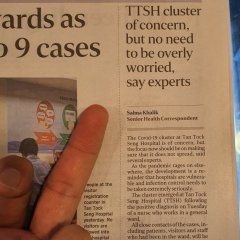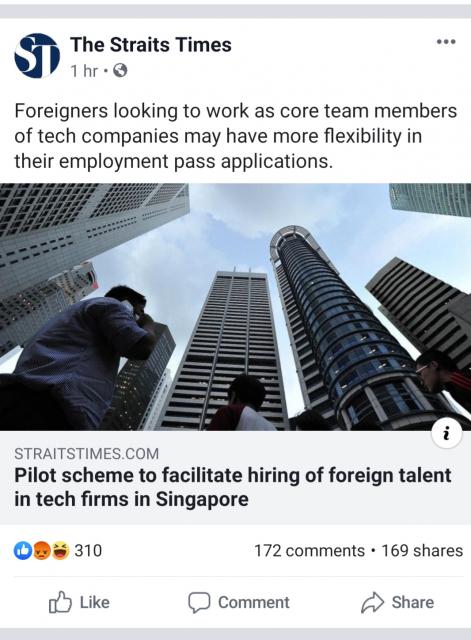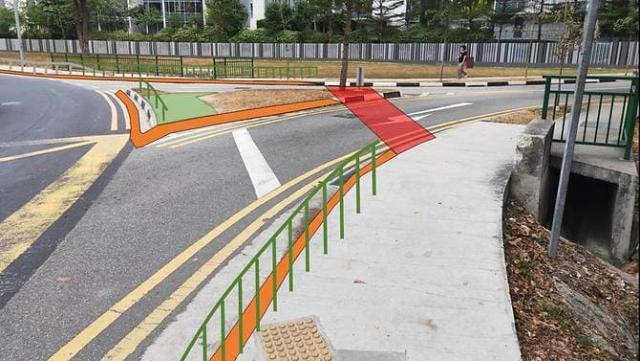Search the Community
Showing results for tags 'Changes'.
-
SINGAPORE: The TOTO jackpot just got bigger. But it will cost you more and it will be more difficult to win the jackpot. In changes that will take effect from Oct 7, An ordinary bet of six numbers will now cost S$1 as opposed to 50 cents previously, while System 7 will now cost S$7, as compared to...
- 171 replies
-
- 2
-

-
- toto
- 49 numbers
-
(and 1 more)
Tagged with:
-
https://www.straitstimes.com/tech/pilot-scheme-to-facilitate-hiring-of-foreign-talent-in-tech-firms?utm_medium=Social&utm_campaign=STFB&utm_source=Facebook#Echobox=1564531412
- 156 replies
-
- 10
-

-
- foreigners
- tech
-
(and 6 more)
Tagged with:
-
I hope this move can aid in having more enforcement check, nail down violators to the Fire Safety Act and Fire Code, and indirectly saving more lives. SCDF can appoint third parties to conduct checks under proposed changes to Fire Safety Act SINGAPORE: The Singapore Civil Defence Force (S...
- 14 replies
-
- 8
-

-
- fire safety
- fire safety act
-
(and 7 more)
Tagged with:
-
SINGAPORE: Several measures will be put in place to reduce vehicular speed and improve pedestrian safety at the roundabout in Marine Parade where a fatal accident took place in March. Announcing the measures on Monday (May 20), the Land Transport Authority (LTA) said it will implement tighter t...
- 79 replies
-
- 9
-

-
- roundabout
- marine parade
-
(and 5 more)
Tagged with:
-
This was brought up a few days ago, in the "President" 's policy suggestions... Instead of stopping people using their CPF to pay for their mortgages, why not reduce the prices if HDB flats and not peg them to market prices with land prices? Then Singaporeans will have more money to save with lower...
-
https://www.channelnewsasia.com/news/world/australia-prime-minister-scott-morrison-malcolm-turnbull-10647458 The PM musical chairs continue. 6th PM in 10 years. @jamesc. another of your good friend out of a job.
-
In case some of you may not notice, some observations recently : 1. Traffic Red Light Camera now doubles as a Speed Camera mostly 50-60 km/h limit. So when driving through these junctions please observe the speed limit even its Green. 2. At some junctions, Pedestrian 'GO' Green Light seem to...
- 16 replies
-
- 3
-

-
- bmw
- bmwtraffic light changes
- (and 6 more)
-
Hi I read from papers saying that this month onwards can change our old parking coupons to new one with revise price Can anyone advise me where can I get it done? Regards Airwave
- 1 reply
-
- hyundai
- hyundaisdw
- (and 7 more)
-
FYI bros .. especially those who still use phone at the red light when vehicle is stationary. please note it is now illegal to do so without a mount. http://www.straitstimes.com/news/singapore/transport/story/what-you-need-know-about-the-new-changes-the-road-traffic-act-feb-1-2 SINGAPORE - A...
- 111 replies
-
- 10
-

-
- road traffic act
- mobile phone
-
(and 4 more)
Tagged with:
-
OK I have been receiving so many PM regarding what is said in the title, I will explain and make this sticky. Upon receiving your new Aveo, you will be entitled 3 free servicing. Please note that the servicing labor is free but the engine oil is not. SA will supply the oil and you have to pay...
-
For those still affected. Me ang teng kee gia liao, 11B sayonara bye bye lo so heng bo wa eh dai ji liao SAF to hire more professionals to enhance NSFs' training By Saifulbahri Ismail POSTED: 06 Mar 2014 14:29 The Singapore Armed Forces will employ more professional trainers to make...
-
Read from ST 'Breaking News' " : SingTel hints at fee changes in letter to BPL subscribers Singtel lost a match against a government ruling on cross-carriage earlier this month, but launched a counter-attack last week by sending a strongly worded letter to its BPL subscribers. In the lett...
-
Remember as a kid when you yearned for those crazy Hot Wheels cars that changed color when you dunked them in hot and cold water? It was about as much fun as you could have, short of striking first in a game of roshambo. It's the kind of fun you just can't have as an adult. Fortunately, a small UK...
-
Hello Folks! Were very excited to announce the new myCarForum forum board and interface! As we're very happy with some of the recent changes we've made, we want to share them with you! These changes are meant to bring about a better user experience. The below are some of the major changes. You...
-
SINGAPORE: Several MPs have raised their concerns in Parliament over the latest changes to car ownership policies. Under the Monetary Authority of Singapore (MAS) car loan curbs, buyers have a maximum of five years to their service car loans. They also have to foot a downpayment of 40 per...
-
The current Mitsubishi Lancer model was first introduced in 2007 and it is a very popular model. You could see it almost anywhere and it is named as the Mitsubishi Lancer EX locally. The model was given a refreshed look, roughly a couple of years back and it is rumoured that the next gene...
-
- other news
- japan
- (and 8 more)
-
Seriously never remember parents last time getting so uptight about the PSLE or exams in general. Maybe we were from a kampong and the common response of these mostly uneducated folks including mine towards exams was "buay tak chek to ker cho gang lo" (If one can't pass an exam, the next recour...
-
From ST: By Christopher Tan Car buyers will get a small reprieve as a planned cut in COE supply from August will now be more measured. In an announcement following Transport Minister Lui Tuck Yew's pronouncement on mitigating the COE supply crunch early this month, the Land Transport Auth...
-
The STOMPer was not clear about this "stationary" car. Was the car on the road waiting behind another vehicle or at a traffic light junction waiting to move off OR was it illegally parked along the road when the bus hit it? If it is the former then the owner's insurer can file a valid clai...
-
Guys, got a very noob question. Assuming totally no obstructions (this means you are accelerating only. No need to brake or anything): Will it save more fuel to: always shift gear up ASAP or wait for current gear to go past optimal torque (or some other point) before shiftin...
- 23 replies
-
- Fuel
- efficiency
-
(and 2 more)
Tagged with:
-
SINGAPORE: From this year, Singaporeans will get absolute priority over permanent residents when it comes to balloting for primary school places. The Education Ministry said where balloting is required during Primary One registration, Singaporeans will be admitted first ahead of permanent resid...
- 728 replies
-
- THANK
- opposition
-
(and 2 more)
Tagged with:
-
fact is it is really easy, have DIY it myself. Change fuel filter took me couple of mins to do it and cost me $3 for the fuel filter. Nothing too complex. simple easy step to change fuel filter 1) Take out the fuse of the fuel pump then start the engine, engine will stall in a while as no f...
-
Hello. After getting feedback that many members' mail box gets flooded by MCF notifications, we have done some adjustments. 1) Default email notification will be "Daily Email digest". This will ensure that you get one notification per day only. 2) "Delayed email notification" has b...





















